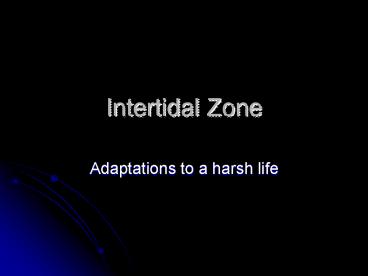Intertidal Zone PowerPoint PPT Presentation
1 / 20
Title: Intertidal Zone
1
Intertidal Zone
- Adaptations to a harsh life
2
Definition of Intertidal
- Also known as the littoral zone
- The area between the high water mark and the low
water mark - Where the land meets the ocean
- Sometimes dry sometimes wet
3
- The intertidal zone is rich with nutrients that
are replenished with each tide - Each wave that enter the zone carries with it
more plankton that the organisms that live in
this area survive on - Dead animals and plants also enter this area
feeding scavengers like hermit crabs and shore
crabs - Constantly redesigned by three forces wind,
water and rock - Winds move across the rock eroding it as each
wave carries more sediment away
4
High and Low Tide
Remember that tides are caused by the gravity of
the sun and The moon. Approximately twice a day
the ocean swells as water Is pulled away from the
center of the earth due to these forces. This
creates a high tide.
5
Type of Shore Line
- Rocky shore
- Occur on steep coasts with very little sediment
- Occur on active margins where the land was
recently uplifted - Can be caused by erosion of sediment due to wave
action - Soft shore
- Areas where large amount of sediment has
accumulated more later
6
Typical Rocky Shore
7
Soft Bottom Shore
8
Water Loss
- The loss of water is also called desiccation
- Intertidal animals must avoid major desiccation
and tolerate minor desiccation - This is a problem because these animals only have
gills to breathe and eat only other marine
organisms - All organisms are approximately 70 percent water
and need to retain that water to live
9
Examples of Intertidal Animals
- A periwinkle is commonly found in the higher
zones of the intertidal area - It can survive days without being submerged
- A sea urchin is found in areas that remain wet 99
percent of the time either in the low zones or
in tide pools - It would die if exposed to air for any extended
period of time
10
Run and Hide Strategy
- Movement of animals to follow the tide
- Animals move to areas that remain wet when the
tide goes out - Some animals only live in those areas that remain
wet and are shaded at all times tide pools are
depressions that hold water when the tide goes
out
11
Clam up Strategy
- The animals that use this type of strategy have a
protective covering like a shell that they close
to prevent water loss - These animals clamp themselves close to the rock
sometimes even creating depressions and seal
the opening - Some animals produce a mucus that they use to
help prevent water loss from openings they can
not close
12
Dry Out Strategy
- Some animals allow themselves to just dry out
- A chiton has the ability to loose 70 percent of
its water and still survive
13
Temperature
- Sea water remains relatively constant but air
temperatures vary dramatically - All animals in the littoral zone must be able to
tolerate extreme changes including animals in
the tide pools - Some animals have the ability just to withstand
this variance Others.. - move to areas that have water and are shade
- Have a lighter shell color to reflect light
- Have ridges to help get rid of excess heat
14
Light color reflects light
Ridges allow heat to escape
15
Salinity
- Fluctuates largely due to
- Rain dilutes the water in tide pools
- Evaporation increases the salinity because only
pure water evaporates living the salt behind - Animals often tolerate these changes by
- Sealing off their shells to the environment
- Burrowing into the environment
- Not tolerating it they die in extreme cases
16
Picture of a crab burrowing into A rock crevice
17
Feeding Restrictions
- Most of the organisms in the littoral zone are
filter feeders or predators - Filter feeders filter food out of the water using
feeding appendages - This means that they must go without food during
low tide when there is not food to filter or when
they have their shells closed to prevent
desiccation - In areas where the tide is out for long periods
of time the animals grow more slowly due to the
lack of food
18
Coping with Wave Shock
- Animals that live in an area with wave shock are
usually sessile and have a means of anchoring
themselves to the rock - Seaweed uses holdfasts
- Mussels and other shell fish uses byssal threads
as the animal moves new threads are attached to
the rock and the old ones are detached - Limpets and chitons use their radula to suction
to the rock - Fish in this area lack a swim bladder which
allows them to sink to the bottom
19
Mussel with Byssal thread Attached to glass
20
Wave Shock
- Shell shape also helps an animal survive wave
shock - Shells of organisms in areas where there is a lot
of wave shock tend to be compact in shape and
have thick shells - In times of strong wave action like during
storms mortality is high - As rocks are turned over those that live on top
are crushed and those that lived on the bottom
often are not adapted to the exposure they face
on top

